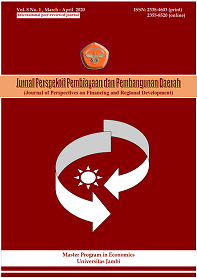Do gender and age of bank clients have an impact on bank card usage?
DOI:
https://doi.org/10.22437/ppd.v8i1.8839Keywords:
Card usage, Consumer Behavior, Female Entrepreneurship, GenderAbstract
This paper attempts to investigate the ownership and usability of debit and credit cards in Kosovo focusing on two demographic variables: the gender and age of the bank's clients. For research purposes, the Central Bank of Kosovo (CBK) data are used for two consecutive years: 2015 and 2016. The comparative method is used to compare the clients’ behavior on the choice of the method to conduct payment and the usage of credit and debit cards in Kosovo banks for two consecutive years 2015 and 2016 based on the gender and age of bank clients. The results show that there is a gender gap, as debit and credit cards are owned and used more by males than females in all age groups and payment types. Whereas, for the variable age, the results show that both debit and credit cards are mostly used by customers aged 25-35 years followed by those 18-25 years. Based on the results of the paper, conclusions were drawn and some suggestions were given. We suggest that banks should do more to enhance the ownership and usage of debit and credit cards by females and elderly clients. Regarding the variable gender, we suggest that banks should offer credit and bonus cards with preferential rates to female entrepreneurs considering the very small number of female entrepreneurs to boost female entrepreneurship and decrease female unemployment in Kosovo.
Downloads
References
Abdul-Muhmin, A. G., & Umar, Y. A. (2007). Credit Card Ownership and Usage Behaviour in Saudi Arabia: The Impact of Demographics and Attitudes toward Dept. Journal of Financial Services Marketing, 12(3), 219 - 234
Avdullahi, A. (2014). Acceptance of E-Banking Services from Small and Medium Enterprises. Horizons International Scientific Journal Economic, 12, 51-62
Avdullahi, A., & Fejza, V. (2015). Efficiency Improvement and Quality Initiatives Application in Financial Institutions. Iliria International Review, 5(1), 133-147.
Bryman, A. (2012). Social Research Methods (4 ed.). New York, United States of America: Oxford University Press Inc.
CBK. (2016). Use of bank cards in Kosovo. CBAK. Prishtina: Central Bank of Kosovo CBK. Retrieved from https://bqk-kos.org/repository/docs/2015/ Use% 20of% 20bank% 20cards%20in%20Kosovo.pdf
CBK. (2017). Use of bank cards in Kosovo. CBAK. Prishtina: Central Bank of Kosovo. Retrieved from https://bqk-kos.org/repository/docs/SistemiIPagesave/ Use% 20of% 20bank%20cards%20in%20Kosovo.pdf
Chaker, M. N. (2015). Consumers's perceptions of banks country of origin in the UAE. Eurasian Journal of Economics and Finance, 3(3), 25-34.
Connolly, S., & Stavins, J. (2015). Payment Instrument Adoption and Use in the United States, 2009 - 2013, by Consumers' Demographic Characteristics. Boston: Federal Reserve Bank of Boston Research Data Report .
Dospinescu, O., Anastasiei, B., & Dospinescu, N. (2019). Key Factors Determaning the Ecpeted Benefit of Customrs When Using Bank Cards: An Analysis on Millennials and Generation Z in Romania. Symmetry, 11(12), 2-20.
Eyubolu, K. & Sevim, U. (2017). Determinants of Contactless Credit Cards Acceptance in Turkey. International Journal of Management, Economics and Business, 13(2), 331-346.
Fejza, V., Bajrami, H., & Livoreka, R. (2018). Consumer Behavior in Commercial Banks of Kosovo. International Journal of Business and Management, VI(2), 17-35.
H. Lee, M., & John W, S. (1969). Social Class and Commercial Bank Credit Card Usage. Journal of Marketing, 33(1), 71-78. doi:10.1177/002224296903300112
Kaynak, E., Kucukemiroglu, O., & Ozmen, A. (1995). Correlates of Credit Card acceptance in advanced developing Middle Eastern Country. Journal of Sevices Markeing, 9(40), 52 - 63
Keller, K., & Kotler, P. (2012). Marketing Management. 14th Edition. New Jersey: Prentice Hall.
Lim, H. C., Ramayah, N. N., & Aizzat, M. N. (2002). Cardholders' attitude and bank credit card usage in Malaysia: An exploratory study. Asian Academy of Management Journal, 7(1), 122-134.
Mann, J. R. (2007). Charging Ahead: The Growth and Regulation of Payment Card Markets. New York, United States of America: Cambridge University Press.
Nguyen, O. D., & Cassidy, J. F. (2018). Consumer Intention and Credit Card Adoption in Vietnam. Asia Pacific Journal of Market Logistics, 30(4), 779-796.
Ragin, C. C., & Rubinson, C. (2009). The Distinctiveness of Comparative Research. In Landman, T & Robinson, N. (Eds.), The Sage Handbook of Comparative Politics, 13 – 34. Sage Publishing
Raiffeisen Bank. (2020). Raiffeisen Bank Kosovo. Retrieved from https://www.raiffeisen-kosovo.com/eng/individuals/products-and-services/cards/bonus-cards/
Sharpe, D. L., Yao, R., & Liao, L. (2012). Correlates of Credit Card Adoption in Urban China. Journal of Family and Economic Issues, 33, 156 - 166
TEB, B. (2020). SheCard – The unique card for her Retrieved from https://www.teb-kos.com/en/index.php/per-individe/kartelat-individe/shecard-visa/
Vathzala, W., & Anurudh, G. (2009). Consumer Credit Card Ownership and Usage Practices: Empirical Evidence from Sri Lanka. International Journal of Consumer Studies, 33(4), 436-447.
Wang, Y. (2008). Determinants Affecting Consumer Adoption of Contactless Credit Card: An Empirical Study. Cyber Psychology Behavior, 11(6), 687-689.
Wickramsinghe, V., & Gurugamage, A. (2009). Consumer Credit Card Ownership and Usage Practices: Empirical Evidence from Sri Lanka . International Journal of Consumer Studies, 33(4), 436 - 447.
Zandi, G., Mansori, S., & Hai, O. B. (2019). The Effect of Demographic Variables and Ownership on Credit Card Market in Malaysia. International Journal of Financial Research, 10(5), 359-369.
Downloads
Published
How to Cite
Issue
Section
License
Copyright (c) 2020 Ajtene Avdullahi, Vjosa Fejza Ademi

This work is licensed under a Creative Commons Attribution 4.0 International License.

















